Title and Link of Exposition: <“A day in the life of Miki“>
Design:
The design of the website was incredibly simple, as the central focus was on the audio and storytelling of the narrative provided.
The user was able to experience the website by switching perspectives, hiding text, resetting and pausing and playing the audio.
These controls were meant to enhance the user experience and explore the concept of different perceptions. Below are some screenshots of the pages.
Black and White are used as the main colors to convey the simplicity and illustrate that the work described is a work of fiction.
In terms of functionality, white borders and black backgrounds were also used in order to help convey this idea.
Title Page:
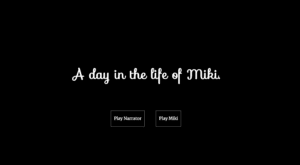
Narrator View:
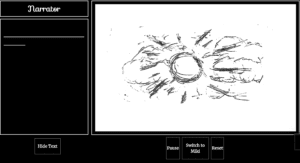
Miki’s View:
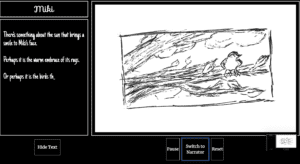
Narrator View (with text hidden):
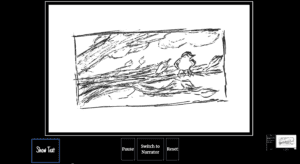
Miki’s View (with text hidden):
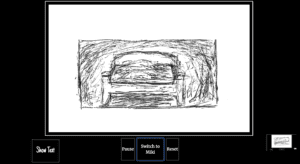
Process:
Please check out my documentation for a thorough explanation of my process.
Future:
Critiques mentioned during my final presentation were mostly stylistic commentary. Here is a list of them:
- It was recommended that the art were to represent different perspectives of the characters being described. The narrator would have a third person view, whereas Miki would have a first-person view.
- It was also recommended that audio and art were to exist in separate perspectives, so the background audio that played would only be audible when Miki’s perspective was presented.
In response, however, I would argue that my concept would discourage such ideas. In terms of representation, as the actions being carried out in the script all occur in the same world, you (as a person within the world) would be experiencing the same things as both the narrator and Miki. The difference here is whether or not you hear the thoughts of the narrator or Miki, as they are subvocalized, and therefore not pertinent when the other person is not being paid attention to. This is mainly seen with the inclusion of Miki’s audible yelling in where she speaks in the world that I created. Because of this, it would make less sense if you could only hear Miki or the narrator, as they participate in a very real world and still have very real effects. If they were in separate realities, however, the criticisms would then most likely be quite valid.
The idea, however, is that you are there, physically. You can see what both of them see, but you cannot hear everything at once. If you did, it would just confuse you. The point is not to confuse you, but rather, have you observe.
However, there are some bugs in the program that I would like to resolve in the future.
There is one issue that I described in the documentation in where the code would restart the audio file that I had played for each line.
For example, I would have a function that asked the source of the audio file to change when a value that measured what line of the script was being printed. Whenever I had a range of numbers, it would not work. And so I either have to manually redo it and have the range equal a series of numbers, or I would have to employ some serious help since the fellows could not help me with the issue. 🙁
Truly, it was a bug to stump many of them.
In other news, I would have liked to add some gradient backgrounds that would have changed the color as the audio and drawings progressed. Additionally, I had to cut off half of the initial story that I had written, which means that the project is incomplete.
Therefore, adding even more assets to the many that I already have is something that I would have to do.
Other than that, I am pretty glad about how it turned out. This is the most complete comm lab project that I have to date, and I worked on it as a solo project – which impressed even me to be completely honest.
Source Credit (FOR BACKGROUND AUDIO ONLY):
The rest of the background audio files were recorded by me, a day before the project was due. Whew, how stressful that was.